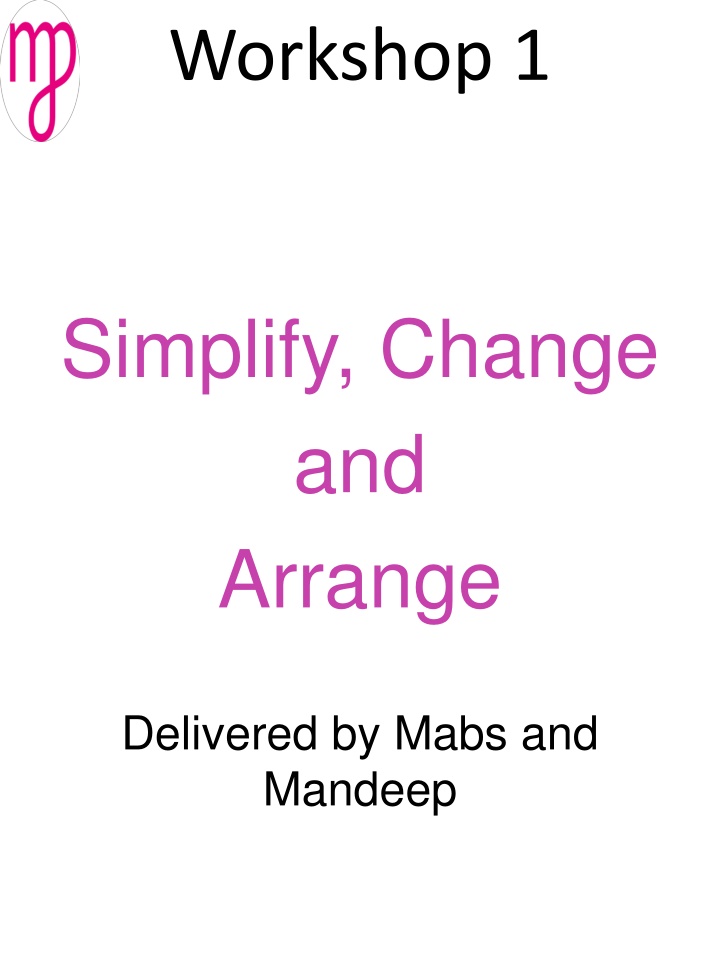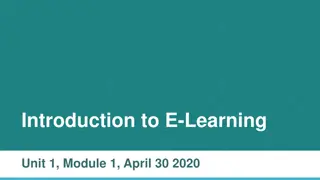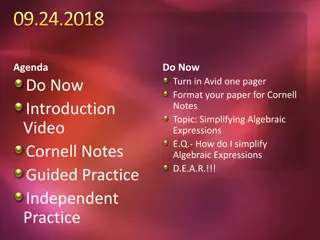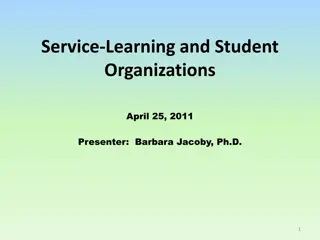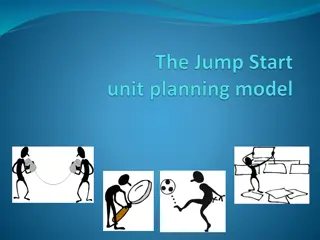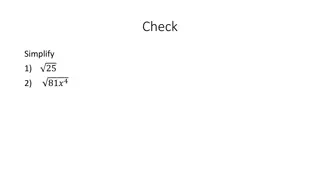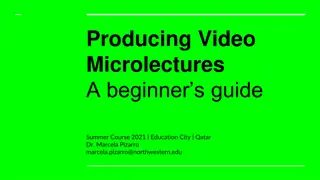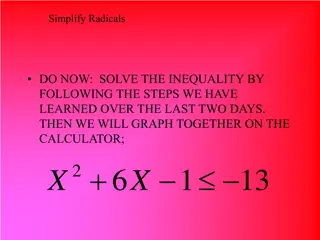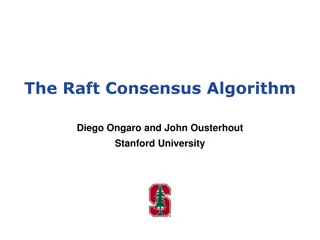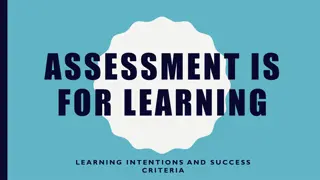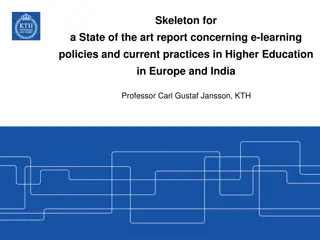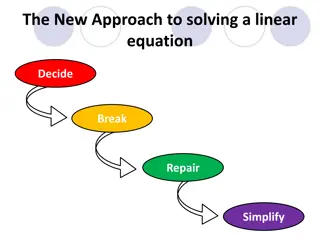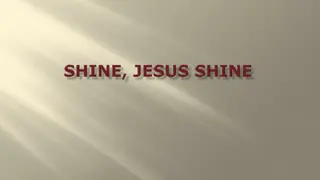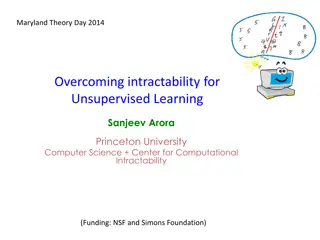Simplifying Learning: Strategies for Effective Education
Emphasizing the importance of simplification in education, this workshop explores techniques such as simplifying, changing, and arranging to enhance learning outcomes. It delves into the Magenta Principles, the significance of language in thinking, and the magic words of simplifying, changing, and arranging. The workshop also discusses the need for simplification in subjects like Maths and Science as a means to aid comprehension and retention.
Download Presentation

Please find below an Image/Link to download the presentation.
The content on the website is provided AS IS for your information and personal use only. It may not be sold, licensed, or shared on other websites without obtaining consent from the author.If you encounter any issues during the download, it is possible that the publisher has removed the file from their server.
You are allowed to download the files provided on this website for personal or commercial use, subject to the condition that they are used lawfully. All files are the property of their respective owners.
The content on the website is provided AS IS for your information and personal use only. It may not be sold, licensed, or shared on other websites without obtaining consent from the author.
E N D
Presentation Transcript
Workshop 1 Simplify, Change and Arrange Delivered by Mabs and Mandeep
Learning is the consequence of thinking therefore our job is to get them to think Language is central to thinking therefore our job is to get them to talk Learning is an active process therefore our job is to get them doing
Magenta Principles? In order to make sense of the information that comes their way, children have to do something with it. We want them to get it, get why they got it and above all Enjoy it!
Magenta Principles? Connect Contrast Arrange Challenge Replace Reduce Change Develop Deconstruct Prioritise
The 3 magic words Simplify - To make less complicated (Breaking it down, Reducing) Change - To make something different (Recreating, Converting) Arrange - To plan and to put into order (Positioning, Creating a big picture)
Why do we need to simplify? Because the students would not be able to access complex subject content and concepts and it would result in them being clueless
Simplify in Maths (Maths) to reduce (an equation, fraction, etc) to a simpler form by cancellation of common factors, regrouping of terms in the same variable, etc Collect like terms in an algebraic expression or cancelling a fractions or ratio
Simplify in Science We; - Use models as representations of the real world. - Clarify understanding by asking simple, basic questions to ascertain the fundamental facts - extract key points from articles or text. - complete storyboards - Flow charts - Tables, Tally charts, Graphs. - Create Hypotheses and test them - Plan and deliver practicals
Using Models- so pupils can apply and link understanding to real world
Examples Aim and Objectives Simplifying objectives to allow students of different abilities to access learning and make progress Topic How to become extinct All - To understand why living things become extinct (Grade C ) Most- List five factors that may cause living things to become extinct (Grade B) Some - Explain the reasons for each one (Grade A/A*)
Simplification in Science Physics Sankey Diagrams to show energy transfer Chemistry - Balancing chemical equations
Simplify the facts into a table Factors for extinctio n Explanation
Factors for extinctio n Explanation Changes to the climate or the Climate environment are the main cause of extinctions throughout history Change In the space of a few million years, Meteorite almost all of the dinosaur species became extinct. Most scientists think there was a big climate change, possibly caused by a giant meteorite hitting the Earth. If a new predator turns up in an Predator area, it can wipe out unsuspecting prey animals very quickly. That s because the prey do not have
Changing the subject In life we change the subject when faced with a topic of conversation that we don t feel comfortable with
Change in Maths Bar chart: change to a different form Story into timeline Change words to pictures and de- code to partners (and vice versa) clarify a piece of work. Paraphrase. To transform or convert To transfer from one (conveyance) to another
Change in Science Pupils will need to do to something to the information they receive in order to make sense of it by changing things around Matching pairs activities Card sort Text into a story board, comic strip, poem, results table into a graph, bar chart First event through to the final event/stage. In reverse order from the final stage to the initial stage.
Change - Poems in Science Brainstorm ideas and create a spider diagram on Light. Use as many words that come to mind. Now convert this mind map into a Poem Mind map on light: Convert into a poem
Bright Star Grey Gas Light Dense Burn Cores
A Poem on Light When it s dark and cold and there s no light look up and you ll see a big star so bright. A star s full of gas that wants to get free. But don t go near. It could burn you or me. Their cores are dense. Some only look grey. We can t really see them during the day.
Cell division Mitosis by Greg Crowther Mitosis is a process (mitosis is a process) by which a cell divides (by which a cell divides). A sequence of four phases (a sequence of four phases) by which it must abide (by which it must abide). CHORUS: Prophase, metaphase, anaphase, telophase (prophase, metaphase, anaphase, telophase) Prophase, metaphase, anaphase, telophase (prophase, metaphase, anaphase, telophase). Now prophase is the first phase (now prophase is the first phase) the chromosomes appear (the chromosomes appear). In metaphase they line up (in metaphase they line up) at the middle of the sphere (at the middle of the sphere). CHORUS The chromosomes are split up (the chromosomes are split up) as anaphase goes by (as anaphase goes by). And telophase then seals em (and telophase then seals em) in brand-new nuclei (in brand-new nuclei). CHORUS
Creating Flow Charts Aim-To use flow charts to help understand reflex pathways.
Arrange in Maths To place in proper, desired, or convenient order; adjust properly: to arrange books on a shelf. To come to an agreement or understanding regarding: The two sides arranged the sale of the property. Music. to adapt (a composition) for a particular style of performance by voices or instruments.
Venn diagram, different graph layouts, human sentence, story line, sort, pick out sentences', for/against, timeline, classify Descending order : largest to smallest Ascending order: smallest to largest Rearrange the formula to make X the subject or y the subject Rearrange the formula so we can work out the value of unknown
Arrange In Science Change the order of steps, in stages or events From low to high, ascending to descending data in graphs/bar charts, demonstrating data in different forms. To plan and sort Historic events creating a timeline when elements were discovered in the periodic table, discovery and development of medicine Chronological order
Arrange results in a table sorting and organising data to make sense of it
The mechanism of natural selection forward_arrow_colour
Question? How will each of you embed and use Simplify, Arrange and Change in your own subjects?
